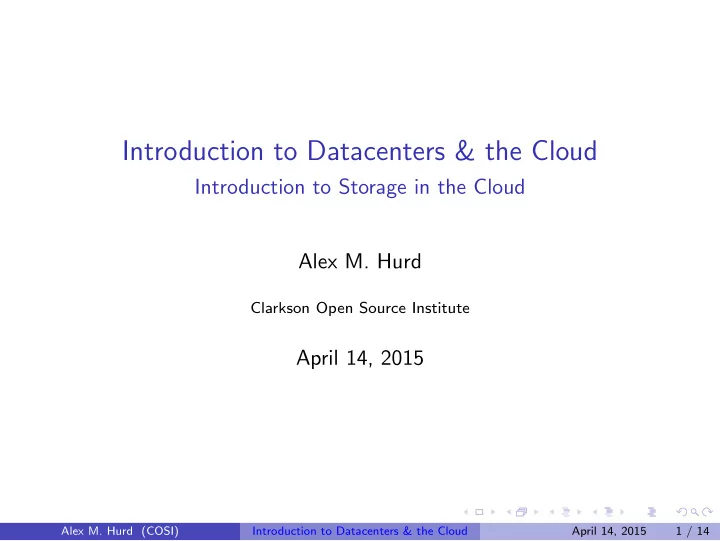

Introduction to Datacenters & the Cloud Introduction to Storage in the Cloud Alex M. Hurd Clarkson Open Source Institute April 14, 2015 Alex M. Hurd (COSI) Introduction to Datacenters & the Cloud April 14, 2015 1 / 14
Overview What is Cloud Storage Pros and Cons Precautions RAID NAS SAN Alex M. Hurd (COSI) Introduction to Datacenters & the Cloud April 14, 2015 2 / 14
What is Cloud Storage Cloud storage is a model of data storage where digital data is stored in logical pools that span multiple servers (and often locations), the physical location is managed by an outside company and not the data’s owner. Providers are responsible for keeping the data available and accessible, as well as keeping the physical location secure and running. People and organizations purchase storage capacity from cloud storage providers. Alex M. Hurd (COSI) Introduction to Datacenters & the Cloud April 14, 2015 3 / 14
History of Cloud Storage Cloud Storage is believed to data back to the 1960 with Joseph Carl Robnett Licklider and his involvement with ARPNET. In 1983 CompuServe offered it’s users 128k of disk space that could store whatever the customer wanted to upload. In 1994 AT&T introduced PersonaLink service, their storage was the first to be all web-based. In 2006 Amazon introduced AWS S3, and became the storage provider for companies like DropBox. Alex M. Hurd (COSI) Introduction to Datacenters & the Cloud April 14, 2015 4 / 14
Architecture Cloud storage is highly virtualized, providing near instant elasticity and scalability. Made up of many distributed systems, but still acts as one. Known as a federated cloud. Highly fault tolerant though redundancy and distribution of data. Highly durable thought versioned copies Alex M. Hurd (COSI) Introduction to Datacenters & the Cloud April 14, 2015 5 / 14
Advantages Companies only pay for what they need, typically billed once a month. Disaster proof storage with backups at multiple geographic locations. Access to data anywhere anytime with multiple devices. Alex M. Hurd (COSI) Introduction to Datacenters & the Cloud April 14, 2015 6 / 14
Issues Data may disappear when the company hosting the data: ◮ Goes Bankrupt ◮ Expand or Change their focus ◮ Be purchased by another company ◮ Be purchased by a company with export restrictions Higher latency Security Alex M. Hurd (COSI) Introduction to Datacenters & the Cloud April 14, 2015 7 / 14
Storing Data in the Cloud Encrypt your data in transit (RSync, SCP, SFTP, etc) Encrypt data before it is transmitted to the storage provider Use strong passwords with encryption and storage providers APIs and Admin Console. Change passwords, and do not use the same one twice. Alex M. Hurd (COSI) Introduction to Datacenters & the Cloud April 14, 2015 8 / 14
Redundant Array of Inexpensive Disks (RAID) Storage virtualization designed to increase redundancy or performance. RAID levels refer to the way in which the data is distributed across the disks. Each RAID level has special requirements, but are all balanced around three goals; Reliability, Availability, Performance, and Capacity. Alex M. Hurd (COSI) Introduction to Datacenters & the Cloud April 14, 2015 9 / 14
RAID6 RAID6 requires a minimum of 5 independent disks There is no performance penalty for read operations Write operations have a penalty for the overhead associated with parity calculations Sometime RAID controllers can have ASICs for calculating parity Alex M. Hurd (COSI) Introduction to Datacenters & the Cloud April 14, 2015 10 / 14
RAID1 RAID1 requires a minimum of 2 independent disks There is a performance increase for read operations Write operations have are only as good as a single drive Alex M. Hurd (COSI) Introduction to Datacenters & the Cloud April 14, 2015 11 / 14
RAID0 RAID0 requires a minimum of 2 independent disks There is a performance increase for write operations Read operations take a latency hit. Alex M. Hurd (COSI) Introduction to Datacenters & the Cloud April 14, 2015 12 / 14
Network Attached Storage (NAS) NAS is a file level data storage server connected to a group of hosts NASs uses NFS for Linux, SMB for Windows, and AFP for OSX communication NASs generally use RAID as a form of redundancy for data stored in the system NASs often run a stripped down version of a full OS Alex M. Hurd (COSI) Introduction to Datacenters & the Cloud April 14, 2015 13 / 14
Storage Area Network (SAN) SANs provide block level storage to connected hosts Most SANs connect to hosts over FiberChannel, AoE, or iSCSI SANs do not provide the file system for the host Alex M. Hurd (COSI) Introduction to Datacenters & the Cloud April 14, 2015 14 / 14
Recommend
More recommend